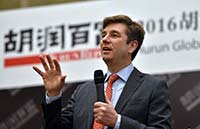Chance to rethink economic policies
By Robert Wihtol and Yolanda Fernandez Lommen (China Daily) Updated: 2012-12-12 13:47Following the 18th National Congress of the Communist Party of China, the new leadership is formulating its economic priorities and policies. The Central Economic Work Conference, an annual policymaking forum, will convene in the coming days. The leadership change provides the conference with an opportunity to take a broad look at the economic challenges facing China and to rethink the policies needed to address them.
A sluggish global economy will continue to provide a challenging backdrop, and efforts need to be stepped up where reforms have slowed. Observers remain skeptical about how quickly some announced policies will be implemented. This is particularly true of plans to reform State monopolies and relax migration controls. These are essential to spur economic efficiency as labor costs rise and the competitiveness of the economy declines.
In the past year, government policymaking has focused on how to implement the reforms set out in the 12th Five-Year Plan (2011-15). Tax policies have been introduced to develop a modern service industry. A plan has been prepared to restructure the country's industrial base. The government has also raised the income tax threshold and plans to increase minimum wage levels to improve living standards and boost consumption.
The Central Economic Work Conference presents a unique opportunity for economic policymakers to reflect on how to make growth more inclusive and sustainable. They face three principal challenges: avoiding the middle-income trap, strengthening the role of the private sector and narrowing the income gap.
China is currently facing the middle-income trap. For more than 30 years, growth has been based on low-cost labor and exports, but this model has now reached its limits. Wages and other production costs have risen sharply, and China can no longer compete with low-income countries. However, because of its relatively low level of technology and innovation, it cannot compete with developed economies either.
Numerous middle-income countries, including Malaysia, the Philippines and Thailand, have got caught in the trap. To avoid the same fate, China must rapidly raise the value-addition of its production.
This requires increased investment in human capital, research and development (R&D) and information and communication technology (ICT), and a strong and vibrant private sector. As production becomes more sophisticated, the technical and vocational skills of the workforce are increasingly important. China currently suffers from skill shortages in several sectors, and a rapidly aging population will reduce rather than increase labor market flexibility.
Education and innovation provide the key. China has increased spending on education, which is expected to reach 4 percent of GDP this year. However, this is still lower than in many other middle-income countries. Developed economies spend between 5 and 7 percent of their GDP on education. Besides, China also needs to move from rote learning to student-centered learning.
China has pockets of excellence, such as Shanghai, whose students have received top international ranking. The challenge is to provide this high standard of education throughout the country. China also needs to improve the quality of its universities.
The government is keenly aware of the need to step up innovation. Spending on R&D is currently 1.8 percent of GDP, and it is set to increase to 2.2 percent by 2015. However, much of this is carried out by State research institutions or enterprises, and the link with manufacturing is weak. China has some innovative enterprises, particularly in ICT and consumer electronics, but the majority continues to focus on production rather than innovation.
The second challenge is to enhance the role of the private sector. This is vital to avoiding the middle-income trap. Without a creative private sector, innovation in economic activity will not take place. Moreover, companies need incentives, financing, and the right policy and legal environment.
The government should also review the role of State-owned enterprises. State monopolies still dominate key areas of the economy. Following an initial rationalization of SOEs in the 1990s, reforms have slowed. The leadership change provides an opportunity to take a fresh look at the issue.
Financial markets are in urgent need of reform. State-owned banks lend mainly to local governments and large SOEs. Small and medium-sized enterprises generate a large share of GDP, provide jobs, and have a stronger track record for innovation than SOEs. However, they have difficulty obtaining financing and have to borrow on the costly informal markets. Estimates of the size of the informal financial markets range from a quarter to nearly half of GDP.
Liberalizing the financial sector will provide all enterprises with access to capital, and reduce their costs. There is also scope to make capital markets more sophisticated and provide investors with new financial options in the domestic and international capital markets.
Strengthening the private sector will benefit the development of services, a cornerstone of economic restructuring as set out in the 12th Five-Year Plan. Services create jobs and generate 90 percent less emissions than manufacturing. A stronger service sector would reduce the carbon footprint of China's rapidly expanding cities, and help absorb rural-urban migrants, supporting government plans to create 45 million new jobs by 2015. Bold reforms are needed, including opening up the sector to foreign direct investment, as was done for manufacturing over two decades ago.
Third, economic decision-makers need to address inequality. The gap between the rich and the poor, and between urban and rural areas, has increased sharply. If not addressed, inequality will undermine the shift to consumption-driven growth, constrain development in poorer regions, and generate social tension.
Fiscal reform and increasing social expenditure provide the solution. Successful reforms in developed economies show that large fiscal transfers for health, education and pensions can effectively reduce inequality. China should overhaul taxation and fiscal transfers to balance income distribution. Policymakers should broaden the tax base, increase the progressivity of taxation, and better align revenue and expenditure responsibilities at the local government level.
Social spending will help raise living standards. Currently, the government spends only 38 percent of revenue on education, health and social security, compared with 52 percent in countries at a similar income level. Its strong fiscal position provides space for China to achieve universal social security coverage and provide equal access to social benefits in urban and rural areas.
Social welfare policies have recently been reformed, including enactment of the 2011 Social Insurance Law, but benefit schemes still need to be unified. This will allow the new leadership to address the social needs that accompany increased labor mobility, continued rural-urban migration, and a rapidly aging population.
The challenges are significant, and the global slowdown highlights their urgency. The leadership change provides an opportunity to ensure that effective policies are put in place to address these challenges and implement the goals of the 12th Five-Year Plan.
Robert Wihtol is director general of the Asian Development Bank's East Asia Department, and Yolanda Fernandez Lommen is head of the economics unit at ADB's China office. The views are the authors' own.
- Plumbing robot debuts in central China
- China's auto industry moves to protect cyber security
- Zijin Mining's profit plummets in H1
- AGV parking robot becomes Internet hit in China
- Total social financing availability jumps in June
- Services industry contributes 54.1% to GDP in first half
- Tencent's music services merged with CMC
- CITIC Securities violations lead to downgrade by CSRC


















